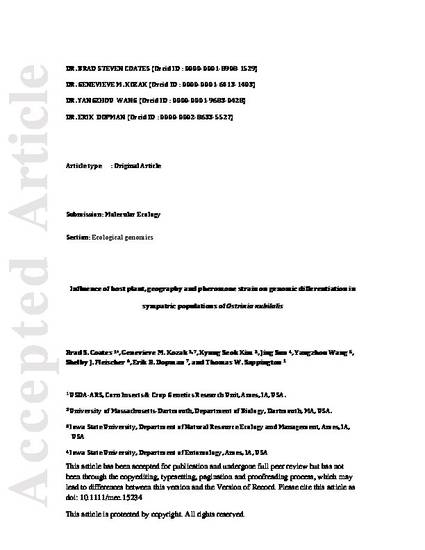
Patterns of mating for the European corn borer (Ostrinia nubilalis) moth depend in part on variation in sex‐pheromone blend. The ratio of (E)‐11‐ and (Z)‐11‐tetradecenyl acetate (E11‐ and Z11‐14:OAc) in the pheromone blend that females produce and males respond to differs between strains of O. nubilalis. Populations also vary in female oviposition preference for and larval performance on maize (C4) and non‐maize (C3) host plants. The relative contributions of sexual and ecological trait variation to the genetic structure of O. nubilalis remains unknown. Host‐plant use (13C/14C ratios) and genetic differentiation were estimated among sympatric E and Z pheromone strain O. nubilalis males collected in sex‐pheromone baited traps at 12 locations in Pennsylvania and New York between 2007 and 2010. Among genotypes at 65 single nucleotide polymorphism marker loci, variance at a position in the pheromone gland fatty acyl‐reductase (pgfar) gene at the locus responsible for determining female pheromone ratio (Pher) explained 64% of the total genetic differentiation between males attracted to different pheromones (male response, Resp), providing evidence of sexual inter‐selection at these unlinked loci. Principal coordinate, Bayesian clustering, and distance‐based redundancy analysis (dbRDA) demonstrate that host plant history or geography does not significantly contribute to population variation or differentiation among males. In contrast, these analyses indicate that pheromone response and pgfar‐defined strain contribute significantly to population genetic differentiation. This study suggests that behavioral divergence likely plays a larger role in driving genetic variation compared to host plant‐defined ecological adaptation.
Available at: http://works.bepress.com/thomas_sappington/118/

This is a manuscript of an article published as Coates, Brad S., Genevieve M. Kozak, Kyung Seok Kim, Jing Sun, Yangzhou Wang, Shelby J. Fleischer, Erik B. Dopman, and Thomas W. Sappington. "Influence of host plant, geography and pheromone strain on genomic differentiation in sympatric populations of Ostrinia nubilalis." Molecular ecology (2019). doi: 10.1111/mec.15234.